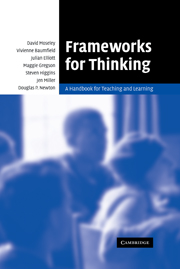Book contents
- Frontmatter
- Contents
- List of figures
- List of tables
- Notes on authors
- Foreword
- Acknowledgments
- Introduction
- 1 The nature of thinking and thinking skills
- 2 Lists, inventories, groups, taxonomies and frameworks
- 3 Frameworks dealing with instructional design
- 4 Frameworks dealing with productive thinking
- 5 Frameworks dealing with cognitive structure and/or development
- 6 Seven ‘all-embracing’ frameworks
- 7 Moving from understanding to productive thinking: implications for practice
- References
- Index
7 - Moving from understanding to productive thinking: implications for practice
Published online by Cambridge University Press: 22 September 2009
- Frontmatter
- Contents
- List of figures
- List of tables
- Notes on authors
- Foreword
- Acknowledgments
- Introduction
- 1 The nature of thinking and thinking skills
- 2 Lists, inventories, groups, taxonomies and frameworks
- 3 Frameworks dealing with instructional design
- 4 Frameworks dealing with productive thinking
- 5 Frameworks dealing with cognitive structure and/or development
- 6 Seven ‘all-embracing’ frameworks
- 7 Moving from understanding to productive thinking: implications for practice
- References
- Index
Summary
Overview
This chapter reviews the potential contribution of the various frameworks, models and taxonomies presented in the book and summarises a number of issues which have arisen. It examines how various taxonomies can inform and support differing aspects and areas of education. It will summarise some problems inherent in classification and theoretical models of thinking. We highlight evidence from meta-analysis to show that thinking skills approaches can be very effective, especially those targeted at the skills of metacognition and self-regulation. Turning to matters of theory, we note a degree of rapprochement between cognitive, constructivist and some recent behaviourist formulations. However, we do not believe that it has been established that meaningful learning can take place only when there is a low level of teacher direction (Hattie, 2002). We point out that a great deal of educational practice is based on sets of widely accepted but usually untested beliefs, values and assumptions. Finally, we outline the value of a practical four-category framework (information gathering; building understanding; productive thinking; strategic management/reflective thinking) that has arisen from our work in this field.
Thinking, learning and teaching
Everyone who is involved in learning needs to have some understanding of its nature and purpose. A framework for understanding thinking and learning can be used at different levels; for example, as a general guide to the formulation of a mission statement or in formulating specific learning objectives and precise assessment items.
Information
- Type
- Chapter
- Information
- Frameworks for ThinkingA Handbook for Teaching and Learning, pp. 296 - 318Publisher: Cambridge University PressPrint publication year: 2005
